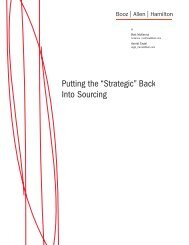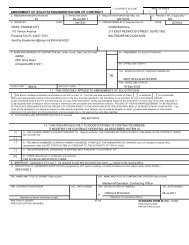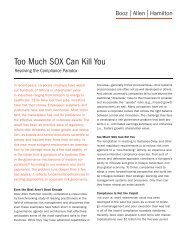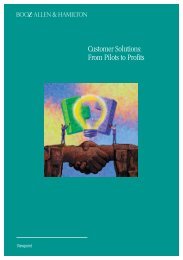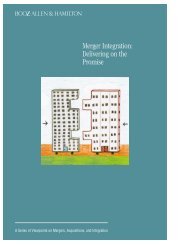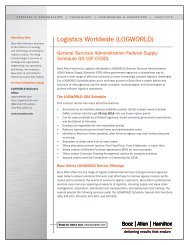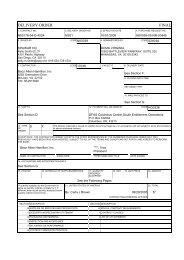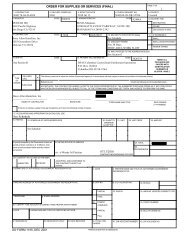Building the Enterprise - Booz Allen Hamilton
Building the Enterprise - Booz Allen Hamilton
Building the Enterprise - Booz Allen Hamilton
- No tags were found...
You also want an ePaper? Increase the reach of your titles
YUMPU automatically turns print PDFs into web optimized ePapers that Google loves.
pected to take that step. 8By 2009, almost all federalpayroll services were consolidatedamong four government-wideshared services providers, and OPMnamed five interagency providersfor personnel services. Today OMBapprovedinteragency shared servicesproviders include <strong>the</strong> InteriorDepartment’s Business Center, <strong>the</strong>Agriculture Department’s NationalFinance Center and seven o<strong>the</strong>rs.These providers offer shared servicesfor budget formulation andexecution, geospatial data, informationsystems security and financialand grants management, in additionto personnel and payroll services.For <strong>the</strong> most part, LoB sharedservices providers have focused onleveraging common business systemssuch as human resources andfinancial management to provideinteragency customers with back-officeand transaction-processing support.This includes such core administrativeservices as cutting payrollchecks and processing promotionactions, posting debits and creditsto an agency’s operating ledger andtracking procurement contracts.The original promise of sharedservices providers has not been met.The vision was that <strong>the</strong>y would assumeeven more of <strong>the</strong> government’scommon administrative workload,including labor-intensive functionssuch as <strong>the</strong> interaction between amanager and a personnel specialistbefore a promotion decision is madeand processed. Now it is time to realizethat promise.Additional enterprise efficienciesare possible. For example, <strong>the</strong>Air Force has consolidated many ofits personnel support services foractive-duty and reserve militarymembers as well as civilian employees,using a sophisticated combinationof online self-service applica-8 CIO Council, Federal Shared Services ImplementationGuide (Washington, DC, April 16,2013).tions, automated voice-responsesystems and live personnel specialiststo provide near full-time coveragefor <strong>the</strong> department’s worldwideforce of nearly 500,000.The Internal Revenue Service’sAgency Wide Shared Services organizationprovides similar consolidatedpersonnel services, such as staffing,labor and employee relations, forits nationally deployed workforce ofmore than 100,000. If such servicescan be provided on this scale withincomplex, diverse and geographicallydispersed agencies, <strong>the</strong>y can be providedas an enterprise portfolio to allagencies.The DOD’s more than three millionmilitary and civilian personnelare paid through a single integratedpayroll system. Its 800,000 civiliansare covered by a single humanresources information system. 9 Yetcivilian employees still are servedby more than 100 separate personneloffices, each providing similarservices under almost <strong>the</strong> same personnelrules using a common humanresources information system.This situation is ripe for consolidation.And <strong>the</strong> Pentagon could offer<strong>the</strong> service on an enterprise basis too<strong>the</strong>r agencies.The o<strong>the</strong>r HR shared servicesproviders, such as <strong>the</strong> Treasury Departmentand <strong>the</strong> National FinanceCenter, can and should follow thissame path. They already providetransaction-level support to multipleagencies and could build uponthat success to offer additional personnelservices to <strong>the</strong>ir interagencycustomers at significant savings,such as drafting job applications.Personnel services are not <strong>the</strong>only area ripe for an enterprise ap-9 Department of Defense, Fiscal 2013 BudgetEstimates, Defense Human Resources Activity(Washington, D.C., Feb. 2012), http://comptroller.defense.gov/defbudget/fy2013/budget_justification/pdfs/01_Operation_and_Maintenance/O_M_VOL_1_PARTS/O_M_VOL_1_BASE_PARTS/DHRA_OP-5.pdf. Lastaccessed Jul. 26, 2013.proach. The Obama administrationhas issued a shared-first policy forfinancial services information technologysystems. On March 25, 2013,former OMB Comptroller DannyWerfel directed all agencies to useone of <strong>the</strong> approved shared servicesfinancial management providers tomodernize <strong>the</strong>ir core accountingsystems.According to Werfel, “<strong>the</strong> cost,quality and performance of federalfinancial systems can be improved byfocusing government resources onfewer, more standardized solutionsthat are implemented and operatedby more experienced staff.” Sharedservices provided using standardizedfinancial systems will reduce<strong>the</strong> risks of large, lengthy financialmanagement system implementationsand make federal financesmore accurate and more transparent,Werfel said. OMB also plans toensure that financial shared servicescenters use common standards andrequirements so agencies retain<strong>the</strong> flexibility to migrate amongproviders.This is exactly <strong>the</strong> sort of enterpriseapproach to shared servicesthat is needed—leveraging commonfunctional requirements, businesssystems and IT infrastructure toprovide mission support in multipleagencies. Indeed, <strong>the</strong>se effortsshould be expanded under <strong>the</strong> auspicesof an enterprise goal leaderfor each of <strong>the</strong> LoB portfolios, withthose goal leaders charged to take<strong>the</strong>m to <strong>the</strong> next level of enterpriseefficiency and effectiveness. •BUILDING THE ENTERPRISE 19





